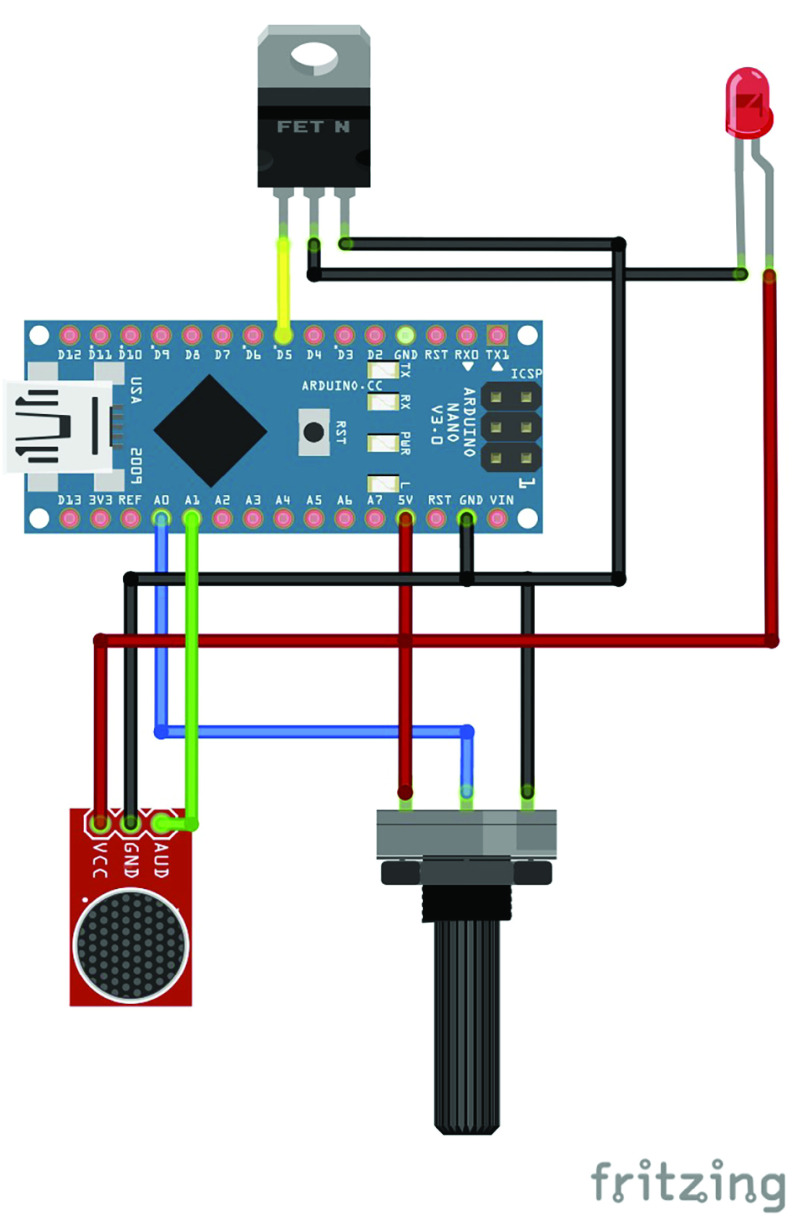Abstract
This case series tests the construction of an extremely low-cost stroboscope and assesses its strengths and weaknesses.
Stroboscopic imaging of the larynx has been the staple of the laryngologist examination since its inception in the past century,1 demonstrating finer details of the vocal folds’ mucosa, its movement patterns, and disturbances, as well as small pathologies that might evade direct or indirect laryngoscopic examination.2,3 Despite the rise of alternative technologies, such as high-speed laryngoscopy and kymography, stroboscopic examination remains a mainstay tool for most laryngologists.4,5,6 The current study aims to test whether a microcontroller can be used to construct an extremely low-cost stroboscope and assesses its strengths and weaknesses.
Methods
This case series study was approved by the Hillel Yaffe Medical Center institutional ethical board (0016-22-HYMC). Oral and written patient informed consent was obtained. The device used an Arduino Nano microcontroller; a microphone; an 18-W, 6500 K LED connected to the main board; and power supplied through an N-type metal-oxide-semiconductor field-effect transistor. A potentiometer was used to adjust the frequency, allowing for transitioning between “freezing” and simulating forward and reverse slow motion of the mucosal wave. The wiring is depicted in the Figure, and the parts used, as well as their price, are summarized in the Table. The system was powered using a standard USB portable power bank.
Figure. Wiring Diagram of the Simple Stroboscope.
Table. Parts Purchased and Prices (at the Time of Purchase).
| Part | Price, $ |
|---|---|
| Type-C Arduino Nano 3.0 clone | 2.67 |
| 18-W, 6500 K white LED | 4.60 |
| Sound sensor module MAX9814 | 1.53 |
| IRF840 N-type MOSFET | 1.64 (10 Pieces) |
| 10-kΏ potentiometer | 1.22 (5 Pieces) |
| 3 × 7-cm Prototype board | 1.25 (5 Pieces) |
| 3.5-mm Stereo jack socket | 0.52 (10 Pieces) |
| Single-row female pin header for Arduino | 1.78 (10 Pieces) |
| Total | 15.21 |
Abbreviation: MOSFET, metal-oxide-semiconductor field-effect transistor.
The code alternates between voice frequency recognition using fast Fourier transform (FFT) and looping the strobe light between on and off positions. The current iteration of the code is shared in the project GitHub page.
The device was tested using a pure tone generator; 256-Hz, 512-Hz, and 1024-Hz tuning forks; and human voice; it resulted in an accuracy of up to plus or minus 6 Hz following testing on human participants.
Results
The total parts price was less than $20. The constructed device dimensions were about 8 × 3 × 4 cm, and it weighed 58 g.
The device was tested on 2 participants, and their stroboscopic images are depicted in the Video.
Video. Low-Cost Stroboscopic Imaging of Vocal Folds.
Demonstration of stroboscopic imaging results from 2 different patients using a low-cost, self-manufactured stroboscope.
The device successfully recognized the frequencies of various voice profiles for male and female participants and with some manual adjustment allowed for accurate stroboscopic imaging of the larynx and the vocal folds, including stop-phase and slow motion. Compared with a commercial stroboscope (Strobolux III LED, Optomic), the device required more manual adjustment and showed short darkness periods during FFT analysis. Synchronization between the commercial module and the capturing device allowed for better recording quality. The open-sourced code allowed for deeper understanding and easier changes in the strobe effects. Additionally, the portability of the constructed device allows for examination outside the clinic (eg, for immobilized or quarantined patients).
Discussion
Stroboscopic examination of the larynx and the vocal folds is an important tool in the laryngologist’s arsenal, allowing for close to an accurate assessment of the vocal folds, the mucosal wave movement, and properties within the mucosa and underlying structures.6
Medical technology devices tend to cost more than adjacent commercial products in the open market; this could be due to the high cost of regulatory demands, additional costs of research and advertisement, lack of competition, or the ability of the paying party to transfer the cost to other parties.
Comparing the ultra-low-cost self-manufactured strobe with a commercial med-tech strobe showed superiority of the commercial technology, although smaller than anticipated, given the price discrepancy. On the other hand, our creation was markedly more portable, allowing for examination outside of the clinic. Limitations of the study included that the tests were limited to 2 participants, and the capturing device’s resolution was sub–high definition.
Future iterations of the device will use 2 connected microcontrollers, allowing improved responsiveness. Additional possible changes could include a separate and direct LED power source, allowing utilization of 48-W LEDs and for a brighter field. This study is mainly an open invitation for collaboration to improve and allow for a better, cheaper, and more open-access medical technology device.
Data Sharing Statement
References
- 1.Van Den Berg J. A Deltaf-generator and movie-adapter unit for laryngo-stroboscopy. Pract Otorhinolaryngol (Basel). 1959;21:355-363. doi: 10.1159/000274225 [DOI] [PubMed] [Google Scholar]
- 2.Sercarz JA, Berke GS, Arnstein D, Gerratt B, Natividad M. A new technique for quantitative measurement of laryngeal videostroboscopic images. Arch Otolaryngol Head Neck Surg. 1991;117(8):871-875. doi: 10.1001/archotol.1991.01870200065009 [DOI] [PubMed] [Google Scholar]
- 3.Tsunoda A, Hatanaka A, Tsunoda R, Kishimoto S, Tsunoda K. A full digital, high definition video system (1080i) for laryngoscopy and stroboscopy. J Laryngol Otol. 2008;122(1):78-81. doi: 10.1017/S0022215107000072 [DOI] [PubMed] [Google Scholar]
- 4.Mehta DD, Hillman RE. Current role of stroboscopy in laryngeal imaging. Curr Opin Otolaryngol Head Neck Surg. 2012;20(6):429-436. doi: 10.1097/MOO.0b013e3283585f04 [DOI] [PMC free article] [PubMed] [Google Scholar]
- 5.Paul BC, Chen S, Sridharan S, Fang Y, Amin MR, Branski RC. Diagnostic accuracy of history, laryngoscopy, and stroboscopy. Laryngoscope. 2013;123(1):215-219. doi: 10.1002/lary.23630 [DOI] [PubMed] [Google Scholar]
- 6.Sulica L. Laryngoscopy, stroboscopy and other tools for the evaluation of voice disorders. Otolaryngol Clin North Am. 2013;46(1):21-30. doi: 10.1016/j.otc.2012.09.001 [DOI] [PubMed] [Google Scholar]
Associated Data
This section collects any data citations, data availability statements, or supplementary materials included in this article.
Supplementary Materials
Data Sharing Statement



